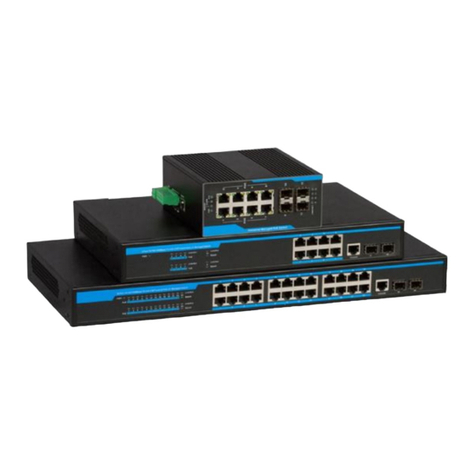
Temperature and Humidity
The switch installation site should maintain a desirable temperature and humidity. High-
humidity conditions can cause electrical resistance degradation or even electric leakage,
degradation of mechanical properties and corrosion of internal components. Extreme low relative
humidity may cause the insulation spacer to contract, making the fastening screw unsecure.
Furthermore, in dry environments, static electricity is liable to be produced and cause harm to
internal circuits. Temperature extremes can cause reduced reliability and premature aging of
insulation materials, thus reducing the switch’s working lifespan. In the hot summer, it is
recommended to use air-conditioners to cool the site. And the cold winter, it is recommenced to
use heaters. The recommended temperature and humidity are shown below:
Caution!
A sample of ambient temperature and humidity should be taken at 1.5m above the floor and
0.4m in front of the switch rack, with no protective panel covering the front and rear of the rack.
Short term working conditions refer to a maximum of 48 hours of continued operation and an
annual cumulative total of less than 15 days. Formidable operation conditions refers to the
ambient temperature and relative humidity value that may occur during an air-conditioning system
failure, and normal operation conditions should be recovered within 5 hours.
Power Supply
The power supply is an adopted module switched power.
Before powering on the power supply, please check the input power to ensure proper
grounding of the power supply system. The input power for the switch should be reliable and
secure; a voltage adaptor can be used if necessary. The building’s circuit protection system should
include in the circuit a fuse or circuit-breaker of no greater than 240 V, 10 A. It is recommended to
use a UPS for more reliable power supplying. .
Caution!
Improper power supply system grounding, extreme fluctuation of the input source, and
transients (or spikes) can result in larger error rate, or even hardware damage!
Preventing Electrostatic Discharge Damage
Static electric can cause damage to internal circuits, even the entire switch. Follow these
guidelines for avoiding ESD damage:
Ensure proper earth grounding of the device;
Perform regular cleaning to reduce dust;
Maintain proper temperature and humidity;
Always wear an ESD wrist strap and antistatic uniform when in contact with circuit
boards.
Anti-interference
All sources of interference, whether from the device/system itself or the outside environment,
will affect operations in various ways, such as capacitive coupling, inductive coupling,
electromagnetic radiation, common impedance (including the grounding system) and cables/lines
(power cables, signal lines, and output lines). The following should be noted:
Precautions should be taken to prevent power source interruptions;
Provide the system with a dedicated grounding, rather than sharing the grounding
with the electronic equipment or lightning protection devices.
Keep away from high power radio transmitters, radar transmitters, and high




























